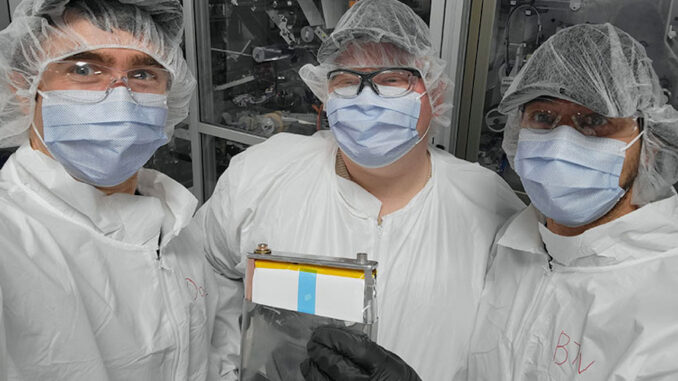
A recent battery manufacturing project led by the US Department of Energy’s National Renewable Energy Laboratory (NREL) —affectionately called BatMan— has developed a novel laser patterning process to alter the microstructure of battery electrode materials. This manufacturing process has the potential to unlock significant improvements to electrified transportation.
“BatMan builds on NREL’s expertise using laser ablation, advanced computational models, and materials characterization to address key challenges in battery manufacturing,” said Bertrand Tremolet de Villers, project co-lead and senior scientist in NREL’s Thin Film and Manufacturing Sciences group.
“This new, high-throughput laser patterning process—demonstrated at scale with state-of-the-art roll-to-roll manufacturing techniques—uses laser pulses to quickly and precisely modify and optimize electrode structures, offering a massive leap in battery capabilities with minimal added manufacturing cost.”
According to Tremolet de Villers and his team, the material makeup, thickness, and structural design of electrodes can impact battery capacity, voltage, and charging speed. For example, doubling the thickness of electrodes from 50 μm to 100 μm increases the energy density of a battery cell by about 16%. However, this increased thickness makes it more difficult to charge the battery quickly without causing long-term damage from lithium plating, which reduces the battery’s lifetime.
Given this state of affairs, the EV industry needs a breakthrough battery design that combines the benefits of thicker electrodes and fast charging without increasing manufacturing costs. The BatMan research team is answering the call with a process that optimizes electrode structures and streamlines battery production.
The pore network
Prior NREL research illuminated how intricate patterns of tiny holes in an electrode—known as the pore network—can unlock battery improvements. These microscopic pores create access points to increase ionic diffusion, allowing the ions to move more quickly during charge and discharge without damaging the battery. As a manufacturing bonus, these pores also speed up electrolyte saturation during the wetting process, which consists of injecting a liquid electrolyte into the cell to facilitate the flow of ions between electrodes.
“Early conversations between NREL’s battery researchers and material scientists uncovered an opportunity to utilize laser ablation to configure these pore networks,” said Donal Finegan, project co-lead and senior scientist in NREL’s Energy Storage group. “With support from our industry partners, BatMan established a new process to incorporate this technique into battery manufacturing. But first, we needed to know which pore patterns would yield the greatest battery benefits.”
Genetic algorithms
To evaluate different pore channel shapes, depth, and distribution, the researchers turned to NREL’s Lithium-Ion Battery Secondary Pore Network Design Optimization Analytical Diffusion Model. The genetic algorithm also considered the specific hardware limitations of the laser used to create the pores. These advanced models helped identify the optimal pore arrangement: a hexagonal pattern of laser-ablated pores with a depth of 50% of the electrode coating thickness. The study also found that adding straight channels across the width of the electrode dramatically improved electrode wetting when compared to unstructured electrodes.
With a target pore network identified, the BatMan team began working toward small-scale prototyping and characterization of the laser-patterned electrode. The scientists used an Amplitude Laser Group femtosecond laser system with high-speed galvanometer-controlled scanning optics for the laser ablation, working closely with the Amplitude team to achieve precise control of the laser based on position, power, frequency, and number of pulses.
“Our collaboration with NREL helped integrate the laser into their existing research capabilities to support the BatMan project goals,” said Quentin Mocaer, line manager at Amplitude. “We also received valuable insights into how future system designs and new technologies could further improve this process at an industrial scale.”
NREL researchers applied advanced characterization tools to evaluate the performance of the laser-ablated electrodes. First, researchers applied X-ray nano-computed tomography and scanning electron microscopy to analyze the morphological features of the electrode structure and validate battery enhancements. Next, NREL’s multiphysics models illustrated how improved uniformity in the structures reduced the risk of lithium plating during fast charging. Finally, the BatMan team assembled small battery cells to assess the optimized electrode architectures in action. Electrochemical analysis of the laser-ablated cells demonstrated superior fast-charge performance, with nearly 100% more capacity after 800 cycles.
Roll-to-roll
After numerous cycles of laser ablation, characterization, and adjustment, it was time to scale up the process for high-throughput demonstration. Most battery manufacturing facilities use a continuous roller-based processing line, known as a roll-to-roll line, that bonds the active material mixture onto a foil surface. Researchers used NREL’s roll-to-roll line to demonstrate and de-risk the compatibility of this new process to encourage adoption by battery manufacturers.
“After nearly three years of research, our team successfully processed 700 meters of double-sided electrode material, proving that laser ablation is a scalable and economically feasible technique for roll-to-roll production of lithium-ion batteries,” Finegan said. “The magnitude of this demonstration was unique to NREL and showcases how strategic laboratory support can advance industry processes.”
NREL returned the optimized electrode material to BatMan’s manufacturing partner Clarios, where experts assembled commercially relevant 27-Ah batteries for further evaluation. Early inspection using Liminal Insights’ EchoStat acoustic imaging indicates that the laser-ablated electrodes wet faster and more uniformly than baseline cells. Additional non-destructive diagnostics will validate the expected performance improvements and ensure battery safety and quality before this technology enters the marketplace.
Time will tell how long it will take before laser-ablated cells find their way into electric vehicles, but the NREL team is optimistic. Techno-economic analysis of the laser patterning process estimates a minimal added cost to battery manufacturing of under $1.50/kWh—that is less than 2%—and the performance advantages are undeniable. NREL researchers also found that the graphite debris collected during the laser ablation process can be directly reused to make new battery cells without any significant impact on the cells’ performance, which presents an opportunity to further reduce the cost of laser ablating electrodes.
“Our lab-scale experimentation shows that laser-ablated electrodes could double the rate of charge of electric vehicles,” Finegan said. “This is a technology evolution that could alter conventional manufacturing, not only for lithium-ion batteries but also next-generation battery chemistries.”

